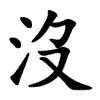沒
- to sink;
- to submerge;
- to drown;
- to vanish;
- to die;
- not, none;
Etymology
An associative compound:
氵 (“water”) — semantic element, indicating relation to water
勹 (“whirl, to wrap”) — represents a swirling current
又 (“hand”) — represents a hand/person
Together they depict a person being engulfed by water, giving the original meaning “to sink, to drown.”
From this sense, extended meanings developed:
- “to die” (by drowning → by extension, to perish)
- “to disappear, to vanish”
- later also “not, none” (as a negator, especially in Chinese)
Usage in Korean
沈沒 (침몰) — to sink, submerge
湮沒 (인몰) — to vanish, be buried, forgotten
沒落 (몰락) — downfall, ruin, collapse
沒收 (몰수) — confiscation, forfeiture
死沒 (사몰) — to die
沒有 (méiyǒu) — not have, there is not (Modern Chinese)
Words that derived from 沒
Additional notes
In Classical Chinese, 沒 primarily meant “to sink, to disappear.”
Later, the sense broadened to “to die, to vanish.” The more specific character 歿 was also used for “to die.”
From the Tang dynasty onward, 沒 developed a negating function (“not, none”).
This arose because the old negator 無 (m- initial) lost its original sound value in Mandarin, so 沒, which shared the same initial, took over as the negator.
In Modern Mandarin, 沒 is polyphonic:
mò → “to sink, to die”
méi → “not, none” (negator, as in 沒有 méiyǒu)
- 水弓水 (ENE)
- ⿰ 氵 ⿱ 勹 又
